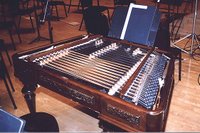Program
Rhapsody No. 1 (Folk Dances) for Cello and Orchestra (1928-29) by Bartok (1881-1945).
Concerto in A minor for Violin, Cello, and Orchestra, "Double," Op. 102 (1887) by Brahms (1833-97).
Naive and Sentimental Music (1998-99) by John Adams (b. 1947).
Tonight’s concert was one of those rare sold-out events for the New York Philharmonic. I am sure Yo-Yo Ma’s appearance had a lot to do with it: proof that big names do draw big crowds.
I had not heard any of the pieces performed tonight, and was looking especially at
Ma, a Paris-born Chinese American, is considered one of the most popular classical musicians. Lately he has branched off to establish the “Silk Road Project” to study traditions along the trade route from the Mediterranean Sea to the 
The Bartok piece consists of two parts: Prima parte (lassu): Moderato and Second parte (friss): Allegretto moderato. The program also mentions Laurence Kaptain on the Cimbalom, a strung percussion instrument that looks oriental to me (see photo). The first part was introduced by a nice melody by the cello, followed by the orchestra. It contains several oft-repeated motifs. The cello sang beautifully at the higher registers. The program notes say Ma has two cellos, a Stradivarious (1712 Davidoff) and a 1733 Montagnana. I wonder which one Ma used today. The second part had a light beginning but got quite heavy and chaotic in the middle. The ending appeared to be tagged on as an after thought. The melodies were written in the tradition of Magyar folk dances. Bartok had written violin/piano, violin/orchestra, and cello/piano arrangements; the orchestra used the violin/orchestra part. Fair enough, I say.
The Concerto was classical Brahms. The first movement (Allegro) started with a short orchestral introduction followed by a cello solo, another orchestra passage was then followed by a violin solo and then a duet. The violin, a 1696 Guarnerius, complemented the cello very well. Although this work was composed for the violin, the cello and the orchestra, I sensed Ma was the center of attention. Was that the work, or the artist? The second movement (Andante) contained several nice melodies, but was played a bit too loudly in my opinion. The third movement (Vivace non troppo) began in a scherzo-like manner with a light staccato. Here the violin was more prominent. The second theme sounded quite serious, but the violin seemed to be mechanically pounding out its part at times. All in all it was a good performance of a lovely piece.
There is an interesting story behind the concerto. Brahms had been good friends with Joseph Joachim, the latter having helped open Schumann’s door to a young Brahms. Their friendship of 30 odd years was strained by Joachim’s belief that Brahms worked against him in Joachim’s divorce from his wife. Brahms wrote this concerto as a means to rebuild their friendship, which did happen to a certain extent. The cellist Brahms had in mind was Robert Hausman, who was also a devoted Brahmsian. Perhaps Brahms was trying to accomplish two objectives simultaneously, and also to make the possible rejection of Joachim less intimidating?
Quite a few people left during the intermission. I guess they did come to see Yo-yo Ma. In any case, Zinman talked to the audience and compared the
For good measure, the music also calls for a guitar (amplified) and many many percussion instruments, including a vibraphone played with a bow. Sure enough the music followed Zinman’s description, and was at times rigid or fluid. The first movement was 19 minutes long (I am sure Zinman said it was 25 minutes long), after which quite a few people walked out. The second movement did sound prairie-like, but not Copland. The third movement didn’t quite go the way I expected. It wasn’t chained to the rhythm in the “marching band” sense, but rather there was always a steady beat somewhere.
In any case, I find the music forgettable. Many in the audience agreed: some even chose to walk out during the music, which is incredibly rude in my judgment. Perhaps
See the New York Times review on a different program featuring Ma and Zinman. The audience there didn’t like the